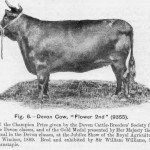What does the “proper” Devon look like…
 ….well, this is what a “good one” looked like 120 years ago. She’s Flower the 2nd, winner of the Gold Medal from the Royal Agricultural Society in 1889. Her breeder was Sir William Williams, Baronet, of Heanton, Barnstaple.
….well, this is what a “good one” looked like 120 years ago. She’s Flower the 2nd, winner of the Gold Medal from the Royal Agricultural Society in 1889. Her breeder was Sir William Williams, Baronet, of Heanton, Barnstaple.
There’s an on-going debate within the two Devon associations over breed “standards” but we think this female could well be the model. (click to enlarge)
Thanks to Juliet Cleave of Cornwall, one of our English partners in Traditional Devon America, for the picture. She sent along a string of old pictures which we’ll be posting in coming days.
6 Comments
mike ortwein
Notice she has horns–looks more like the milking Devons.
David
Can’t resist. All Devon had horns for hundreds of years until, miraculously, the “polled fairy” came down and waved her wand and created the “new, improved” version.
Sorry folks, that ended the “pure Devon” argument in America.
A traditional Devon has horns and the difference between the beef and milking variety is only the result of selection. But you’ll find few of the milking variety, even with their horns, who match this cow.
It’s why several of us formed Traditional Devon and have spent the past few years scouring England (they’re rare there, too) looking for these genetics.
We do dehorn them, though. I’ve been thinking maybe we shouldn’t. My unprofessional, unscientific view is that we do something elemental to an animal when we dehorn it. I sense a change.
red ruby heifer
Kingston Lacey herd is one of the few establishments in the UK that do NOT dehorn their Devons – it was a condition of the legacy (bequeathed to the National Trust). Meanwhile, some UK ‘purists’ steer away from polled genetics as somewhere along the line, something (other than pure Devon) has been introduced to fix the polled gene…
mike ortwein
I have two registered milking Devon, a mother and a daughter. When Gerald Fry visited my place he wanted to know how much I would sell the mother for, the daughter at that time was just a baby, but now at two years of age she is better looking than her mom. They both look like your picture.
Rich Maurer
We have 4 milking devons and have found them to be superior to the “beef” devons for some time. In fact, we’re considering shifting to milking devons exclusively. We’ve found the meat tastes better, less health issues, and NO predator issues (who’d mess with those weapons – yes! we keep the female’s horns in tact). Plus, if you tame them well enough to milk, you get pretty awesome milk, although I admit I’ve never tasted the milk from a purely beef devon cow to compare.
Their oxen heritage is without question. We tried to put “Betty”, our senior milking devon cow, in a traditional milking stanchion and couldn’t snap it shut because her neck too thick, a good 4″ wider than the historical holsteins. I had to weld an extension in place so I could use it. (pictures on our web site)
Regina Tesnow
Thank you for sharing these pictures, it gives us a guideline as to what we should be breeding towards.
One of the things I notice is the undercarriage on these two. It is parallel to the topline, no tuck up by the loin. I have always thought it should be this way and have a few in our fields that look like this.